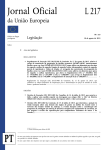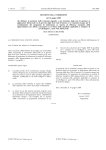Download ENERGY STAR Program Requirements for Computers (DRAFT
Transcript
ENERGY STAR® Program Requirements
for Computers
Partner Commitments
Following are the terms of the ENERGY STAR Partnership Agreement as it pertains to the manufacture
and labeling of ENERGY STAR qualified products. The ENERGY STAR Partner must adhere to the
following partner commitments:
Qualifying Products
1. Comply with current ENERGY STAR Eligibility Criteria, which define performance requirements and
test procedures for computers. A list of eligible products and their corresponding Eligibility Criteria can
be found at www.energystar.gov/specifications.
2. Obtain certification of ENERGY STAR qualification from a Certification Body recognized by EPA for
computers prior to associating the ENERGY STAR name or mark with any product. As part of this
certification process, products must be tested in a laboratory recognized by EPA to perform computer
testing.
Using the ENERGY STAR Name and Marks
3. Comply with current ENERGY STAR Identity Guidelines, which define how the ENERGY STAR name
and marks may be used. Partner is responsible for adhering to these guidelines and ensuring that its
authorized representatives, such as advertising agencies, dealers, and distributors, are also in
compliance. The ENERGY STAR Identity Guidelines are available at www.energystar.gov/logouse.
4. Use the ENERGY STAR name and marks only in association with qualified products. Partner may not
refer to itself as an ENERGY STAR Partner unless at least one product is qualified and offered for
sale.
5. Provide clear and consistent labeling of ENERGY STAR qualified computers.
5.1. Partner shall adhere to the following product-specific commitments regarding use of the ENERGY STAR certification mark on qualified products: 5.1.1. Partner must use the ENERGY STAR mark in one of the following ways:
1) Via permanent or temporary label on the top or front of the product. All temporary
labeling must be affixed to the product with an adhesive or cling-type application; or
2) Via electronic labeling. Electronic labeling must meet the following requirements:
a. The ENERGY STAR mark in cyan, black, or white must appear at system start
up, and must display for a minimum of 5 seconds;
b. The ENERGY STAR mark must be at least 10% of the screen by area, must
not be smaller than 76 pixels x 78 pixels, and must be legible.
EPA will consider alternative proposals for electronic labeling on a case-by-case
basis.
5.1.2. If additional information about the ENERGY STAR program or other products is
provided by the Partner on its website, Partner must comply with the ENERGY STAR
Web Linking Policy, which can be found at www.energystar.gov/partners;
6. Work with Value Added Resellers (VARs) of Partner’s products to help ensure that computer products
remain in compliance with ENERGY STAR requirements.
ENERGY STAR Program Requirements for Computers – Partner Commitments
1
6.1. Any party within the distribution channel of an ENERGY STAR qualified computer that alters the
power profile of a product after its date of manufacture through hardware or software
modifications must ensure that the product continues to meet the ENERGY STAR requirements
before delivering this product to the end customer. If the product no longer meets the
requirements, it may not bear the ENERGY STAR mark;
6.2. If a VAR makes any modifications to a computer that was previously qualified as ENERGY
STAR, re-brands the product, and promotes it as ENERGY STAR, the VAR must become an
ENERGY STAR Partner and follow the requirements outlined in this document.
Verifying Ongoing Product Qualification
7. Participate in third-party verification testing through a Certification Body recognized by EPA for
computers.
8. Comply with tests that EPA/DOE may conduct at its discretion on products that are referred to as
ENERGY STAR qualified. These products may be obtained on the open market, or voluntarily
supplied by Partner at the government’s request.
Providing Information to EPA
9. Provide unit shipment data or other market indicators to EPA annually to assist with creation of
ENERGY STAR market penetration estimates, as follows:
9.1. Partner must submit the total number of ENERGY STAR qualified computers shipped in the
calendar year or an equivalent measurement as agreed to in advance by EPA and Partner.
Partner shall exclude shipments to organizations that rebrand and resell the shipments
(unaffiliated private labelers).
9.2. Partner must provide unit shipment data segmented by meaningful product characteristics (e.g.,
type, capacity, presence of additional functions) as prescribed by EPA.
9.3. Partner must submit unit shipment data for each calendar year to EPA or an EPA-authorized
third party, preferably in electronic format, no later than March 1 of the following year.
Submitted unit shipment data will be used by EPA only for program evaluation purposes and will be
closely controlled. Any information used will be masked by EPA so as to protect the confidentiality of
the Partner;
10. Report to EPA any attempts by laboratories or Certification Bodies (CBs) to influence testing or
certification results or to engage in discriminatory practices.
11. Notify EPA of a change in the designated responsible party or contacts within 30 days using the My
ENERGY STAR Account tool (MESA) available at www.energystar.gov/mesa.
Training and Consumer Education
12. Partner shall comply with the following, product-specific requirements concerning training and
education:
12.1. Agree to complete steps to educate users of their products about the benefits of power management by including the following information with each ENERGY STAR qualified computer in the user manual or as part of a printed box insert: 12.1.1. Energy and cost savings potential;
12.1.2. Environmental benefits; and
12.1.3. The ENERGY STAR logo, plus information on ENERGY STAR and a link to
www.energystar.gov.
12.2. Include a link to www.energystar.gov/powermanagement from product web pages, product
specifications, and related content pages.
ENERGY STAR Program Requirements for Computers – Partner Commitments
2
12.3. At the Partner’s request, EPA will supply suggested facts and figures related to the above
criteria, template elements, or a complete template suitable for use in user guides or box inserts.
Performance for Special Distinction
In order to receive additional recognition and/or support from EPA for its efforts within the Partnership, the
ENERGY STAR Partner may consider the following voluntary measures, and should keep EPA informed
on the progress of these efforts:
Provide quarterly, written updates to EPA as to the efforts undertaken by Partner to increase
availability of ENERGY STAR qualified products, and to promote awareness of ENERGY STAR and
its message.
Consider energy efficiency improvements in company facilities and pursue benchmarking buildings
through the ENERGY STAR Buildings program.
Purchase ENERGY STAR qualified products. Revise the company purchasing or procurement
specifications to include ENERGY STAR. Provide procurement officials’ contact information to EPA for
periodic updates and coordination. Circulate general ENERGY STAR qualified product information to
employees for use when purchasing products for their homes.
Feature the ENERGY STAR mark(s) on Partner website and other promotional materials. If
information concerning ENERGY STAR is provided on the Partner website as specified by the
ENERGY STAR Web Linking Policy (available in the Partner Resources section of the ENERGY
STAR website), EPA may provide links where appropriate to the Partner website.
Ensure the power management feature is enabled on all ENERGY STAR qualified displays and
computers in use in company facilities, particularly upon installation and after service is performed.
Provide general information about the ENERGY STAR program to employees whose jobs are relevant
to the development, marketing, sales, and service of current ENERGY STAR qualified products.
Provide a simple plan to EPA outlining specific measures Partner plans to undertake beyond the
program requirements listed above. By doing so, EPA may be able to coordinate, communicate,
and/or promote Partner’s activities, provide an EPA representative, or include news about the event in
the ENERGY STAR newsletter, on the ENERGY STAR website, etc. The plan may be as simple as
providing a list of planned activities or milestones of which Partner would like EPA to be aware. For
example, activities may include: (1) increasing the availability of ENERGY STAR qualified products by
converting the entire product line within two years to meet ENERGY STAR guidelines; (2)
demonstrating the economic and environmental benefits of energy efficiency through special in-store
displays twice a year; (3) providing information to users (via the website and user’s manual) about
energy-saving features and operating characteristics of ENERGY STAR qualified products; and (4)
building awareness of the ENERGY STAR Partnership and brand identity by collaborating with EPA
on one print advertorial and one live press event.
Join EPA's SmartWay Transport Partnership to improve the environmental performance of the
company's shipping operations. The SmartWay Transport Partnership works with freight carriers,
shippers, and other stakeholders in the goods movement industry to reduce fuel consumption,
greenhouse gases, and air pollution. For more information on SmartWay, visit
www.epa.gov/smartway.
Join EPA's Climate Leaders Partnership to inventory and reduce greenhouse gas emissions. Through
participation, companies create a credible record of their accomplishments and receive EPA
recognition as corporate environmental leaders. For more information on Climate Leaders, visit
www.epa.gov/climateleaders.
Join EPA’s Green Power Partnership. EPA's Green Power Partnership encourages organizations to
buy green power as a way to reduce the environmental impacts associated with traditional fossil fuelbased electricity use. The partnership includes a diverse set of organizations including Fortune 500
companies, small and medium businesses, government institutions as well as a growing number of
colleges and universities. For more information on Green Power, visit www.epa.gov/greenpower.
ENERGY STAR Program Requirements for Computers – Partner Commitments
3
ENERGY STAR® Program Requirements Product Specification for Computers Eligibility Criteria
Draft Version 5.2 1
2
Following is the Version 5.2 ENERGY STAR Product Specification for Computers. A product shall meet all
of the identified criteria if it is to earn the ENERGY STAR.
3
1 DEFINITIONS
4
A) Product Types:
5
6
7
8
9
10
1) Computer: A device which performs logical operations and processes data. For the purposes of
this specification, computers include both stationary and portable units, including desktop
computers, integrated desktop computers, notebook computers, small-scale servers, thin clients,
and workstations. Although computers are capable of using input devices and displays, such
devices are not required to be included with the computer upon shipment. Computers are
composed of, at a minimum:
11
a) A central processing unit (CPU) to perform operations;
12
b) User input devices such as a keyboard, mouse, digitizer or game controller; and
13
14
c) An integrated display screen and/or the ability to support an external display screen to output
information.
15
16
17
18
19
20
21
22
23
24
25
26
27
28
29
30
31
32
33
34
35
2) Desktop Computer: A computer whose main unit is designed to be located in a permanent
location, often on a desk or on the floor. Desktop computers are not designed for portability and
are designed for use with an external display, keyboard, and mouse. Desktop computers are
intended for a broad range of home and office applications.
a) Integrated Desktop Computer: A desktop computer in which the computing hardware and
display are integrated into a single housing, and which is connected to ac mains power
through a single cable. Integrated desktop computers come in one of two possible forms: (1) a
system where the display and computer are physically combined into a single unit; or (2) a
system packaged as a single system where the display is separate but is connected to the
main chassis by a dc power cord and both the computer and display are powered from a
single power supply. As a subset of desktop computers, integrated desktop computers are
typically designed to provide similar functionality as desktop systems.
3) Notebook Computer: A computer designed specifically for portability and to be operated for
extended periods of time both with and without a direct connection to an ac mains power source.
Notebook computers include an integrated display and are capable of being powered by an
integrated battery or other portable power source. In addition, most notebooks use an external
power supply and have an integrated keyboard and pointing device. Notebook computers are
typically designed to provide similar functionality to desktops, including operation of software
similar in functionality as that used in desktops. For purposes of this specification, tablet
computers, which use both a touch-sensitive screen and a physical keyboard, are considered
Notebook Computers.
ENERGY STAR Program Requirements for Computers – Eligibility Criteria
Page 1 of 18
36
37
38
39
40
41
42
Note: Slate computing devices are defined loosely as a type of computer lacking a physical keyboard,
relying solely on touchscreen input, having solely a wireless network connection (e.g., Wi-Fi, 3G), and
primarily powered from an internal battery (with connection to the mains for charging, not primary
powering of the device). This group of emerging devices are marketed independently of the notebook
computer and Smartphone designations. Two similar computer types are referenced in the ENERGY
STAR computer specification: tablet computers are within scope as part of the notebook type, yet
“handhelds” are explicitly excluded from the program.
43
44
45
46
47
48
For the purposes of this specification, EPA considers Slate computing devices to be under the handheld
type and consequently not eligible for the ENERGY STAR computer program at this time. It is important
that EPA consider closely the usage modes and power profile of any computer type within the ENERGY
STAR computer program to ensure efficiency levels and requirements are appropriate and fair. EPA will
proceed with further review of slates with the intent to address such products in the next revision to this
specification.
49
50
51
52
53
54
4) Small-scale Server: A computer that typically uses desktop components in a desktop form factor,
but is designed primarily to be a storage host for other computers. Small-scale Servers are
designed to perform functions such as providing network infrastructure services (e.g., archiving)
and hosting data/media. These products are not designed to process information for other
systems or run web servers as a primary function. A Small-scale Server has the following
characteristics:
55
56
a) Designed in a pedestal, tower, or other form factor similar to those of desktop computers such
that all data processing, storage, and network interfacing is contained within one box/product;
57
58
b) Designed to operate 24 hours/day, 7 days/week, with minimal unscheduled downtime (on the
order of hours/year);
59
60
c) Capable of operating in a simultaneous multi-user environment serving several users through
networked client units; and
61
62
d) Designed for an industry accepted operating system for home or low-end server applications
(e.g., Windows Home Server, Mac OS X Server, Linux, UNIX, Solaris).
63
64
65
66
67
68
5) Thin Client: An independently-powered computer that relies on a connection to remote computing
resources to obtain primary functionality. Main computing functions (e.g., program execution, data
storage, interaction with other Internet resources) are provided by the remote computing
resources. Thin Clients covered by this specification are (1) limited to devices with no rotational
storage media integral to the computer and (2) designed for use in a permanent location (e.g. on a
desk) and not for portability.
69
70
71
72
73
74
6) Workstation: A high-performance, single-user computer typically used for graphics, CAD, software
development, financial and scientific applications among other compute intensive tasks.
Workstations covered by this specification (a) are marketed as a workstation; (b) provide mean
time between failures (MTBF) of at least 15,000 hours (based on either Bellcore TR-NWT-000332,
issue 6, 12/97 or field collected data); and (c) support error-correcting code (ECC) and/or buffered
memory. In addition, a workstation meets three or more of the following criteria:
75
76
a) Provide supplemental power support for high-end graphics (e.g., PCI-E 6-pin 12V
supplemental power feed);
77
78
b) Provide more than 4 PCI-E slots on the motherboard (i.e., greater than x4) in addition to
graphics slot(s) and/or PCI-X support;
79
c) Do not provide support for Uniform Memory Access (UMA) graphics;
ENERGY STAR Program Requirements for Computers – Eligibility Criteria
Page 2 of 18
80
d) Provide 5 or more PCI, PCI-E, or PCI-X slots;
81
82
83
e) Provide support for 2 or more processors (shall support physically separate processor packages/sockets, i.e., requirement cannot be met with support for a single multi-core processor); and/or 84
85
f)
Qualification by 2 or more Independent Software Vendor (ISV) product certifications; these certifications can be in process, but shall be completed within 3 months of qualification. 86
87
88
B) Product Category: A second-order classification or sub-type within a product type that is based on product features and installed components. Product categories are used in this specification to determine qualification and test requirements. 89
C) Computer Components:
90
91
92
93
94
1) Display: A display screen and its associated electronics encased in a single housing, or within the
computer housing (e.g., notebook or integrated desktop computer), that is capable of displaying
output information from a computer via one or more inputs, such as a VGA, DVI, Display Port,
and/or IEEE 1394. Examples of computer display technologies are the cathode-ray tube (CRT)
and liquid crystal display (LCD).
95
96
2) Discrete Graphics Processing Unit (GPU): A graphics processor with a local memory controller interface and local graphics-specific memory. 97
98
99
100
101
3) External Power Supply (EPS): Also referred to as External Power Adapter. A component
contained in a separate physical enclosure external to the computer casing, designed to convert
line voltage ac input from the mains to lower dc voltage(s) in order to provide power to the
computer. An external power supply shall connect to the computer via a removable or hard-wired
male/female electrical connection, cable, cord or other wiring.
102
103
104
105
106
107
108
109
110
111
112
4) Internal Power Supply (IPS): A component internal to the computer casing and designed to
convert ac voltage from the mains to dc voltage(s) for the purpose of powering the computer
components. For the purposes of this specification, an internal power supply shall be contained
within the computer casing but be separate from the main computer board. The power supply
shall connect to the mains through a single cable with no intermediate circuitry between the power
supply and the mains power. In addition, all power connections from the power supply to the
computer components, with the exception of a DC connection to a display in an Integrated
Desktop Computer, shall be internal to the computer casing (i.e., no external cables running from
the power supply to the computer or individual components). Internal dc-to-dc converters used to
convert a single dc voltage from an external power supply into multiple voltages for use by the
computer are not considered internal power supplies.
113
D) Operational Modes:
114
115
116
117
1) Off Mode: The lowest power mode which cannot be switched off (influenced) by the user and that
may persist for an indefinite time when the appliance is connected to the main electricity supply
and used in accordance with the manufacturer’s instructions. For systems where ACPI standards
are applicable, Off Mode correlates to ACPI System Level S5 state.
118
119
120
121
122
123
2) Sleep Mode: A low power mode that the computer enters automatically after a period of inactivity
or by manual selection. A computer with Sleep capability can quickly “wake” in response to
network connections or user interface devices with a latency of less than or equal to 5 seconds
from initiation of wake event to system becoming fully usable including rendering of display. For
systems where ACPI standards are applicable, Sleep Mode most commonly correlates to ACPI
System Level S3 (suspend to RAM) state.
ENERGY STAR Program Requirements for Computers – Eligibility Criteria
Page 3 of 18
124
125
126
3) Idle State: The power state in which the operating system and other software have completed
loading, a user profile has been created, activity is limited to those basic applications that the
system starts by default, and the computer is not in Sleep Mode.
127
128
129
130
4) Active State: The power state in which the computer is carrying out useful work in response to a)
prior or concurrent user input or b) prior or concurrent instruction over the network. Active State
includes active processing, seeking data from storage, memory, or cache, including Idle State
time while awaiting further user input and before entering low power modes.
131
E) Networking and Additional Capabilities:
132
133
1) Additional Internal Storage: Any and all internal hard disk drives (HDD) or solid state drives (SSD)
shipping with a computer beyond the first. This definition does not include external drives.
134
135
136
2) Network Interface: The components (hardware and software) whose primary function is to make
the computer capable of communicating over one or more network technologies. Examples of
Network Interfaces are IEEE 802.3 (Ethernet) and IEEE 802.11 (Wi-Fi).
137
138
139
140
141
3) Wake Event: A user, scheduled, or external event or stimulus that causes the computer to
transition from Sleep Mode or Off Mode to an active state of operation. Examples of wake events
include, but are not limited to: movement of the mouse, keyboard activity, controller input, real
time clock event, or a button press on the chassis, and in the case of external events, stimulus
conveyed via a remote control, network, modem, etc.
142
143
4) Wake On LAN (WOL): Functionality which allows a computer to transition from Sleep Mode or Off
Mode to an Active State of operation when directed by a network Wake Event via Ethernet.
144
145
146
147
148
149
150
151
152
5) Full Network Connectivity: The ability of the computer to maintain network presence while in low
power modes and intelligently wake when further processing is required (including occasional
processing required to maintain network presence). Presence of the computer, its network
services and applications, is maintained even though the computer is in a low power mode. From
the vantage point of the network, a computer with full network connectivity that is in low power
mode is functionally equivalent to an idle computer with respect to common applications and
usage models. Full network connectivity in low power mode is not limited to a specific set of
protocols but can cover applications installed after initial installation. Also referred to as “network
proxy” functionality.
153
154
g) Network Proxy - Base Capability: To maintain addresses and presence on the network while
in low power mode, the system handles IPv4 ARP and IPv6 NS/ND.
155
156
h) Network Proxy - Remote Wake: While in low power mode, the system is capable of remotely
waking upon request from outside the local network. Includes Base Capability.
157
158
i)
Network Proxy - Service Discovery/Name Services: While in low power mode, the system
allows for advertising host services and network name. Includes Base.
159
160
j)
Network Proxy - Full Capability: While in low power mode, the system supports Base
Capability, Remote Wake, and Service Discovery/Name Services.
161
162
163
164
Notes: The Full Network Connectivity definition has been revised to refer generically to “low power mode”
instead of Sleep Mode. Provisions (a) through (d) have been added in reference to final provisions in the
Ecma International ECMA-393 standard. These partial implementations of the network proxy are reflected
in tables 5 and 6.
ENERGY STAR Program Requirements for Computers – Eligibility Criteria
Page 4 of 18
165
F) Marketing and Shipment Channels: 166
167
168
1) Enterprise Channels: Sales channels typically used by large and medium-sized business, government, educational, or other organizations to purchase computers for use in managed client/server environments. 169
170
171
2) Model Number: A unique marketing name or identification reference that applies to a specific hardware and software configuration (e.g., operating system, processor type, memory, GPU), and is either pre-defined or selected by a customer. 172
173
3) Model Name: A marketing name that includes reference to the computer model number, product description, or other branding references. 174
175
176
177
178
179
180
Product Family: A group of product models that are (1) made by the same manufacturer, (2) subject to the same ENERGY STAR qualification criteria, and (3) of a common basic design. Product models within a family differ from each other according to one or more characteristics or features that either (1) have no impact on product performance with regard to ENERGY STAR qualification criteria, or (2) are specified herein as acceptable variations within a product family. For all Computer product types with the exception of Workstations, acceptable variations within a product family include: 181
(1) Color, 182
(2) Number and type of processor, 183
(3) Memory configuration, 184
(4) Number and type of GPU, 185
(5) Number and type of hard-disk drives, 186
(6) Number and type of removable-media drives, 187
(7) Number and type of network or other data (including display) interfaces, 188
(8) Number and type of user input interfaces. 189
190
191
192
193
For Workstations, acceptable variations within a product family include: (1) Number of GPUs Note: The definition for Product Family has been updated to align with standard language across the
program. EPA intends for the previous Version 5.0 product family implementation to remain unchanged in
this revision.
ENERGY STAR Program Requirements for Computers – Eligibility Criteria
Page 5 of 18
194
2 SCOPE 195
2.1
196
197
198
2.1.1
Included Products
Products that meet the definition of a Computer and one of the following Product Type definitions, as specified herein, are eligible for ENERGY STAR qualification, with the exception of products listed in Section 2.2: 199
i.
Desktop Computers,
200
ii.
Integrated Desktop Computers, 201
iii. Notebook Computers, 202
iv. Workstations, 203
v.
204
vi. Thin Clients. Small-scale Servers that are marketed and sold for non-data center use, 205
2.2
206
207
208
2.2.1
Products that are covered under other ENERGY STAR product specifications are not eligible for qualification under this specification. The list of specifications currently in effect can be found at www.energystar.gov/products. 209
2.2.2
The following products are not eligible for qualification under this specification: Excluded Products
210
i.
Computer Servers, as defined in ENERGY STAR Computer Server specification, 211
ii.
Small-scale Servers that are marketed and sold for use in data centers, 212
iii. Handheld Computers, 213
iv. Game Consoles, 214
v.
215
vi. Smart Phones, 216
217
vii. Handheld gaming devices, typically battery powered and intended for use with an integral display as the primary display. 218
219
220
221
Personal Digital Assistant devices (PDAs), Note: Game Consoles will be further addressed under a separate ENERGY STAR product specification,
with development of specialized requirements building on past drafts distributed through the ENERGY
STAR Computer program in late 2009 to early 2010. Drafts and comments related to Game Consoles may
be found at www.energystar.gov/productdevelopment.
ENERGY STAR Program Requirements for Computers – Eligibility Criteria
Page 6 of 18
222
3 QUALIFICATION CRITERIA
223
3.1
224
225
226
3.1.1
All calculations shall be carried out with actual measured or observed values. Only the final result
of a calculation shall be rounded. Calculated results shall be rounded to the nearest significant
digit as expressed in the corresponding specification limit.
227
228
3.1.2
Unless otherwise specified, compliance with specification limits shall be evaluated using exact
values without any benefit from further rounding.
229
3.2
230
3.2.1
Significant Digits and Rounding
Power Supply Requirements
Internal Power Supplies (IPS):
231
232
i.
IPS with maximum rated output current less than 75 watts shall meet minimum efficiency
requirements as specified in Table 1.
233
234
235
ii.
IPS with maximum rated output current greater than or equal to 75 watts shall meet both
minimum efficiency requirements and minimum power factor requirements, as specified in
Table 1.
236
237
238
Note: The highlighted text incorporates an ENERGY STAR program clarification that was distributed by
EPA on June 19, 2009. Please refer to the ENERGY STAR website for further information:
http://www.energystar.gov/ia/partners/downloads/V5_0_Computer_Clarification.pdf
239
3.2.2
External Power Supplies (EPS):
240
241
i.
EPS with integral cooling fans shall meet minimum efficiency requirements and minimum
power factor requirements, as specified in Table 1.
242
243
244
ii.
EPS without integral cooling fans shall meet the level V performance requirements under the
International Efficiency Marking Protocol and include the level V marking. Additional
information on the Marking Protocol is available at www.energystar.gov/powersupplies.
245
246
Table 1: Requirements for Internal Power Supplies and
External Power Supplies with Integral Cooling
Loading Condition
(Percentage of Nameplate
Output Current)
20%
50%
100%
247
3.3
248
249
3.3.1
Minimum
Efficiency
Minimum
Power Factor
0.82
0.85
0.82
0.90
Power Management Requirements
Products shall include power management features in their “as-shipped” condition as specified in
Table 2, subject to the following conditions:
ENERGY STAR Program Requirements for Computers – Eligibility Criteria
Page 7 of 18
250
251
252
253
i.
For Thin Clients, the WOL requirement shall apply products designed to receive software
updates from a centrally managed network while in Sleep Mode or in Off Mode. Thin Clients
whose standard software upgrade framework does not require off-hours scheduling are
exempt from the WOL requirement.
254
255
ii.
For Notebooks, WOL may be automatically disabled when the product is disconnected from
ac mains power.
256
257
iii. For all products with WOL, directed packet filters shall be enabled and set to an industry
standard default configuration.
258
Desktops
Integrated Desktops
Notebooks
Workstations
Small-scale Servers
Thin Clients
Table 2: Power Management Requirements
Sleep Mode
(1) Sleep Mode shall be set to activate
after no more than 30 minutes of user
inactivity.
(2) The speed of any active 1 Gb/s
Ethernet network links shall be
reduced when transitioning to Sleep
Mode or Off Mode.
Yes
Yes
Yes
Yes
No
No
Display Sleep
Mode
(1) Display Sleep Mode shall be set to
activate after no more than 15 minutes
of user inactivity.
Yes
Yes
Yes
Yes
Yes
Yes
Wake on LAN
(WOL)
(1) Computers with Ethernet capability
shall provide users with an option to
enable and disable WOL for Sleep
Mode.
(2) Computers with Ethernet capability
that are shipped through enterprise
channels shall either:
(a) be shipped with WOL enabled by
default for Sleep Mode, when the
computer is operating on ac mains
power; or
(b) provide users with the ability to
enable WOL that is accessible from
both the client operating system user
interface and over the network.
Yes
Yes
Yes
Yes
Yes
Yes
Mode or Mode
Transition
Requirement
ENERGY STAR Program Requirements for Computers – Eligibility Criteria
Page 8 of 18
259
3.4
260
3.4.1
Integrated Desktops
Notebooks
Workstations
Small-scale Servers
Thin Clients
Wake
Management
Desktops
Mode or Mode
Transition
Yes
Yes
Yes
Yes
Yes
Yes
Requirement
(1) Computers with Ethernet capability
that are shipped through enterprise
channels shall:
(a) be capable of both remote (via
network) and scheduled (via realtime clock) wake events from Sleep
Mode, and
(b) provide clients with the ability to
centrally manage (via vendor tools)
any wake management settings that
are configured through hardware
settings if the manufacturer has
control over such features.
User Information Requirements Products shall be shipped with informational materials to notify customers of the following: 261
i.
A description of power management settings that have been enabled by default, 262
ii.
A description of the timing settings for various power management features, and 263
iii. Instructions for properly waking the product from Sleep Mode. 264
3.4.2
Products shall be shipped with one or more of the following: 265
i.
A list of default power management settings. 266
267
268
269
ii.
A note stating that default power management settings have been selected for compliance with ENERGY STAR (within 15 min of user inactivity for the display, within 30 min for the
computer, if applicable per Table 2), and are recommended by the ENERGY STAR program
for optimal energy savings.
270
271
iii. Information about ENERGY STAR and the benefits of power management, to be located at or
near the beginning of the hard copy or electronic user manual, or in a package or box insert.
272
3.5
Requirements for Desktop, Integrated Desktop, and Notebook Computers
273
274
3.5.1
TEC Categories: Desktops, Integrated Desktops shall be evaluated in the categories described in
Table 3, and Notebook Computers shall be evaluated in the categories described in Table 4.
275
276
i.
Products or product configurations shall be evaluated using the highest letter category to
which they apply.
ENERGY STAR Program Requirements for Computers – Eligibility Criteria
Page 9 of 18
277
278
279
ii.
Products available in configurations fitting multiple categories within the appropriate table shall
be evaluated under all appropriate categories and as specified in section Error! Reference
source not found..
280
Discrete GPU
GPU Frame Buffer
Width (bits)
A
System Memory
(GB)
Product
Category
Number of Physical
CPU Cores
Table 3: Categorization of Desktop and Integrated Desktop Computers
<2
Any
Yes or No
N/A or any
Any
< 2.0
Yes or No
N/A or any
B
2
≥ 2.0
Yes or No
N/A or any
C
>2
≥ 2.0
Yes or No
N/A or any
D
≥4
Any
≥ 4.0
Any
Yes
Yes or No
Yes
Any
N/A or any
> 128
281
Number of
Physical CPU
Cores
System Memory
(GB)
Discrete GPU
GPU Frame Buffer
Width (bits)
Table 4: Categorization of Notebook Computers
A
Any
Any
Any
Any
B
Any
Any
Yes
Any
C
≥2
≥ 2.0
Yes
> 128
Product
Category
282
283
284
285
3.5.2
Calculated Typical Energy Consumption (ETEC) per Equation 1 shall be less than or equal to the
maximum TEC requirement (ETEC_MAX), as calculated per Equation 2, subject to the following
requirements:
286
287
i.
The Additional Internal Storage adder (TECSTORAGE) shall be applied if there are one or more
internal storage devices present in the product, in which case it shall only be applied once.
288
289
ii.
For a product to qualify for the Full Network Connectivity weightings, the following criteria shall
be satisfied:
290
291
292
293
•
Products shall meet a non-proprietary Full Network Connectivity standard that has been
approved by the EPA and the European Union as meeting the goals of ENERGY
STAR. Such approval must be in place prior to submittal of product data for
qualification.
ENERGY STAR Program Requirements for Computers – Eligibility Criteria
Page 10 of 18
•
294
295
296
Products shall have the applied level of functionality enabled and configured by default
upon shipment. If Full Network Connectivity features are not enabled by default, the
system shall be tested and reported with Conventional TEC weightings.
297
298
Equation 1: TEC Calculation (ETEC) for Desktop, Integrated Desktop,
and Notebook Computers
299
ETEC = (8760 / 1000) * {(POFF * TOFF) + (PSLEEP * TSLEEP) + (PIDLE * TIDLE)}
300
301
302
303
304
305
306
Where:
POFF = Measured power consumption in Off Mode (W)
PSLEEP = Measured power consumption in Sleep Mode (W)
PIDLE = Measured power consumption in Idle Mode (W)
TOFF, TSLEEP, and TIDLE are mode weightings as specified in Table
5 (for Desktops and Integrated Desktops) or Table 6 (for
Notebooks).
307
Equation 2: ETEC_MAX Calculation for Desktop, Integrated Desktop,
308
ETEC_MAX = TECBASE + TECMEMORY + TECGRAPHICS + TECSTORAGE
309
310
311
312
Where:
TECBASE , TECMEMORY , TECGRAPHICS , and TECSTORAGE are adders
as specified in Table 7 (for Desktops and Integrated Desktops) or
Table 8 (for Notebooks).
313
Table 5: Mode Weightings for Desktop and Integrated Desktop Computers
Full Network Connectivity
Mode
Weighting
Conventional
Toff
Base
Capability
Remote Wake
Service
Discovery/Na
me Services
Full Proxying
55%
50%
47%
43%
40%
Tsleep
5%
14%
20%
25%
30%
Tidle
40%
36%
33%
32%
30%
314
Table 6: Mode Weightings for Notebook Computers
Full Network Connectivity
Remote Wake
Service
Discovery /
Name
Services
Full Proxying
54%
49%
48%
45%
10%
18%
24%
26%
30%
30%
28%
27%
26%
25%
Mode
Weighting
Conventional
Toff
Base
Capability
60%
Tsleep
Tidle
ENERGY STAR Program Requirements for Computers – Eligibility Criteria
Page 11 of 18
315
316
TECGRAPHICS (kWh)
(GPU Frame Buffer Width ≤ 128-bit)
(per GB > 2.0)
50.0
(Applies once if system
has more than one
Additional Internal
Storage element.)
TECMEMORY (kWh)
Where: m = System
Memory (GB)
148.0
1.0
TECSTORAGE (kWh)
TECBASE (kWh)
Product Category
Table 7: Maximum TEC Allowances
for Desktop and Integrated Desktop Computers
35.0
A
25.0
(GPU Frame Buffer Width > 128-bit)
35.0
B
175.0
1.0
(GPU Frame Buffer Width ≤ 128-bit)
(per GB > 2.0)
50.0
25.0
(GPU Frame Buffer Width > 128-bit)
C
209.0
D
234.0
317
1.0
50.0
(per GB > 2.0)
(GPU Frame Buffer Width > 128-bit)
1.0
50.0
(per GB > 4.0)
(GPU Frame Buffer Width > 128-bit)
25.0
25.0
318
3.6
319
320
3.6.1
53.0
C
88.5
(Applies once if system
has more than one
Additional Internal
Storage element.)
B
0.4
-
3.0
0.4
3.0
(per GB > 4.0)
(GPU Frame Buffer Width > 64-bit)
3.0
(per GB > 4.0)
0.4
(per GB > 4.0)
-
TECSTORAGE (kWh)
40.0
TECGRAPHICS (kWh)
TECBASE (kWh)
A
TECMEMORY (kWh)
Where: m = System
Memory (GB)
Product Category
Table 8: Maximum TEC Allowances for Notebook Computers
3.0
Requirements for Workstations
Weighted power consumption (PTEC) as calculated per Equation 3 shall be less than or equal to
the maximum weighted power consumption requirement (PTEC_MAX) as calculated per Equation 4.
321
ENERGY STAR Program Requirements for Computers – Eligibility Criteria
Page 12 of 18
322
Equation 3: PTEC Calculation for Workstations
323
PTEC = (POFF * TOFF) + (PSLEEP * TSLEEP) + (PIDLE * TIDLE)
324
325
326
327
328
329
Where:
POFF = Measured power consumption in Off Mode (W)
PSLEEP = Measured power consumption in Sleep Mode (W)
PIDLE = Measured power consumption in Idle Mode (W)
TOFF, TSLEEP, and TIDLE are mode weightings as specified in Table
9
330
Table 9: Mode Weightings for Workstations
TOFF
0.35
TSLEEP
0.10
TIDLE
0.55
331
332
Equation 4: PTEC_MAX Calculation for Workstations
333
PTEC_MAX ≤ 0.28 * {PMAX + (NHDD * 5)}
334
335
336
337
Where:
PMAX = Measured maximum power consumption (W)
NHDD = Number of installed hard disk drives (HDD) or solid state
drives (SSD)
338
339
340
341
3.6.2
Desktop Workstations: Products marketed as workstations may qualify for ENERGY STAR under
the Desktop requirements in Section 3.5, instead of the Workstation requirements in Section 3.6.1,
at the Partner’s option. EPA will identify Workstations qualified as Desktops as “Desktops” in all
ENERGY STAR marketing materials, on qualified product lists, etc.
342
343
344
Note: Requirement 3.6.2 has been added to clarify the administrative process for Workstations that qualify
under the TEC requirements for Desktops. The policy defined in this section and in Section 4.2.1 was
established after finalization of the Version 5.0 specification.
345
3.7
346
347
348
3.7.1
Requirements for Small-scale Servers
Measured Off Mode power (POFF) shall be less than or equal to the maximum Off Mode power
consumption requirement (POFF_MAX) listed in Table 10, as calculated per Equation 5, subject to
the following requirements:
349
i.
Products shall be evaluated using the highest letter category to which they apply.
350
351
ii.
The Off Mode Wake-On-LAN (WOL) adder (POFF_WOL) shall only be applied to products that
offer WOL that is enabled by default upon shipment.
352
Equation 5: Calculation of POFF_MAX for Small-scale Servers
353
POFF_MAX = POFF_BASE + POFF_WOL
ENERGY STAR Program Requirements for Computers – Eligibility Criteria
Page 13 of 18
354
355
3.7.2
Measured Idle State power (PIDLE) shall be less than or equal to the maximum Idle State power
consumption requirement (PIDLE_MAX) specified in Table 10.
356
357
Table 10: Classification & Power Consumption Requirements
for Small-scale Servers
Small-scale Server Classification
358
3.8
359
360
361
3.8.1
Operational Mode Requirements
Product
Category
Number of
Physical
Cores or
Discrete
Processors
A
any
any
2.0
0.7
50.0
B
>1
> 1.0
2.0
0.7
65.0
System
Memory
(GB)
POFF_BASE
(watts)
POFF_WOL
(watts)
PIDLE_MAX
(watts)
Requirements for Thin Clients
Measured Off Mode power (POFF) shall be less than or equal to the maximum Off Mode power
consumption requirement (POFF_MAX) in Table 11, as calculated per Equation 6, subject to the
following requirements.
362
i.
Products shall be evaluated using the highest letter category to which they apply.
363
364
ii.
The Off Mode Wake-On-LAN (WOL) adder (POFF_WOL) shall only be applied to products that
offer WOL that is enabled by default upon shipment.
365
Equation 6: Calculation of POFF_MAX for Thin Clients
366
POFF_MAX = POFF_BASE + POFF_WOL
367
368
369
3.8.2
For products that offer a Sleep Mode, measured Sleep Mode power (PSLEEP) shall be less than or
equal to the maximum Sleep Mode power consumption requirement (PSLEEP_MAX) in Table 11, as
calculated per Equation 7, subject to the following requirement.
i.
370
371
The Sleep Mode Wake-On-LAN (WOL) adder (PSLEEP_WOL) shall only be applied to products
that offer WOL that is enabled by default upon shipment.
372
Equation 7: Calculation of PSLEEP_MAX for Thin Clients
373
PSLEEP_MAX = PSLEEP_BASE + PSLEEP_WOL
374
375
3.8.3
Measured Idle State power (PIDLE) shall be less than or equal to the maximum Idle State power
consumption requirement (PIDLE_MAX) specified in Table 11.
ENERGY STAR Program Requirements for Computers – Eligibility Criteria
Page 14 of 18
376
377
Table 11: Classification & Power Consumption Requirements
for Thin Clients
Thin Client Classification
A
Support for
Local
Multimedia
Encode and
Decode
-
B
Yes
Product
Category
378
4 TESTING
379
4.1
380
381
4.1.1
Operational Mode Requirements
POFF_BASE
(watts)
POFF_WOL
(watts)
PSLEEP_BASE
(watts)
PSLEEP_WOL
(watts)
PIDLE_MAX
(watts)
2.0
0.7
2.0
0.7
12.0
2.0
0.7
2.0
0.7
15.0
Test Methods
When testing Computer products, the test methods identified in Table 12 shall be used to
determine ENERGY STAR qualification.
382
Table 12: Test Methods for ENERGY STAR Qualification
Product Type or
Component
All
Test Method
ENERGY STAR Test Method for Computers, Rev. Aug-2010
Internal Power
Supply
Multi-output External
Power Supply
Single-output
External Power
Supply with Integral
Cooling
383
4.2
384
4.2.1
EPRI Generalized Internal Power Supply Efficiency Test Protocol,
Rev. 6.4.2 (available at www.efficientpowersupplies.org)
Number of Units Required for Testing
Representative Models shall be selected for testing per the following requirements:
385
386
387
i.
For qualification of an individual product configuration, the unique configuration that is
intended to be marketed and labeled as ENERGY STAR is considered the Representative
Model.
388
389
390
ii.
For qualification of a product family of all product types, with the exception of Workstations,
product configurations that represent the worst-case power consumption for each product
category within the family are considered Representative Models.
391
392
393
iii.
For qualification of a product family of Workstations under the Workstation or Desktop
product type, each unique configuration with a single GPU that is intended to be marketed
and labeled as ENERGY STAR is considered the Representative Model.
ENERGY STAR Program Requirements for Computers – Eligibility Criteria
Page 15 of 18
394
395
396
4.2.2
A single unit of each Representative Model shall be selected for testing. If test results for any
operational mode power measurement are within 10% of ENERGY STAR requirements, two
additional units of the same Representative Model with an identical configuration shall be tested.
397
4.2.3
All tested units shall meet ENERGY STAR qualification requirements.
398
4.3
399
400
4.3.1
401
4.4
402
403
4.4.1
International Market Qualification
Products shall be tested for qualification at the relevant input voltage/frequency combination for
each market in which they will be sold and promoted as ENERGY STAR.
Customer Software and Management Service Pre-Provisioning
If a manufacturing Partner is hired by a customer to load a custom image to an ENERGY STAR
qualified computer, the Partner shall take the following steps:
404
405
i.
Inform the customer that their product may not meet ENERGY STAR with the custom image.
A sample notification letter is available on the ENERGY STAR Web site.
406
ii.
Encourage the customer to test the product for ENERGY STAR compliance.
407
408
409
iii. Encourage the customer, should the product no longer meet ENERGY STAR, to make use of
EPA's free technical assistance that can assist with Power Management performance, which
can be found at www.energystar.gov/fedofficeenergy.
410
5 USER INTERFACE
411
412
413
5.1.1
414
6 EFFECTIVE DATE
415
416
417
418
419
6.1.1
Effective Date: The Version 5.2 ENERGY STAR Computers specification shall take effect on the
dates specified in Table 13. To qualify for ENERGY STAR, a product model shall meet the
ENERGY STAR specification in effect on its date of manufacture. The date of manufacture is
specific to each unit and is the date (e.g., month and year) on which a unit is considered to be
completely assembled.
420
421
422
423
424
6.1.2
Future Specification Revisions: EPA reserves the right to change this specification should
technological and/or market changes affect its usefulness to consumers, industry, or the
environment. In keeping with current policy, revisions to the specification are arrived at through
stakeholder discussions. In the event of a specification revision, please note that the ENERGY
STAR qualification is not automatically granted for the life of a product model.
425
Manufacturers are encouraged to design products in accordance with the user interface standard
IEEE P1621: Standard for User Interface Elements in Power Control of Electronic Devices
Employed in Office/Consumer Environments. For details, see http://eetd.LBL.gov/Controls.
Table 13: Specification Effective Dates
Effective Date
July 1, 2009
ENERGY STAR Program Requirements for Computers – Eligibility Criteria
Page 16 of 18
APPENDIX A:
Sample Calculations
426
427
428
429
430
431
432
433
434
435
436
I.
Desktop, Integrated Desktop, Notebook Computers: Below is a sample TEC calculation intended
to show how levels for compliance are determined based on functional adders and operational mode
measurements.
Following is a sample ETEC evaluation for a Category A Notebook Computer with integrated GPU, 8
GB Memory, and 1 HDD.
A) Measure values using the ENERGY STAR Computers Test Method:
437
4) Off Mode = 1.0 W
438
5) Sleep Mode = 1.7 W
439
6) Idle State = 10.0 W
440
B) Calculate ETEC from power measurements and weightings:
Toff
0.60
Tsleep
0.10
Tidle
0.30
441
1) ETEC = (8760/1000) * (Poff * Toff + Psleep * Tsleep + Pidle * Tidle) 442
2) ETEC = (8760/1000) * (1.0 * 0.60 + 1.7 * 0.10 + 10.0 * 0.30) 443
3) ETEC = 33.03 kWh / year 444
C) Determine which Capability Adjustments apply:
445
1) Discrete Graphics? No, therefore does not apply for Premium Graphics adder.
446
2) Memory: 8 GB installed, meets memory threshold, calculate ((8 – 4) * 0.4 kWh) = 1.6 kWh
447
D) Calculate ETEC_MAX by adding any capability adjustments to the Base TEC requirement: Category A
Category B
40.0
53.0
Category C
88.5
448
1) ETEC_MAX = 40.0 kWh / year + 1.6 kWh / year
449
2) ETEC_MAX = 41.6 kWh / year
450
451
452
E) Compare ETEC to the ETEC_MAX to determine if the model qualifies:
1) 33.03 kWh / year < 41.6 kWh / year
F) Therefore, the notebook meets ENERGY STAR requirements.
453
ENERGY STAR Program Requirements for Computers – Eligibility Criteria
Page 17 of 18
454
455
II. Workstations: Below is a sample PTEC calculation for a Workstation with 2 hard drives.
A) Measure values using the ENERGY STAR Computers Test Method: 456
1) Off Mode = 2 W 457
2) Sleep Mode = 4W 458
3) Idle State = 80W 459
4) Max Power = 180W 460
461
462
B) Note number of Hard Drives installed: 5) Two hard drives installed during test. C) Calculate PTEC from power measurements and weightings using Equation 3: Toff
0.35
Tsleep
0.10
Tidle
0.55
463
6) PTEC = (.35 * Poff + .10 * Psleep + .55 * Pidle) 464
7) PTEC = (.35 * 2 + .10 * 4 + .55 * 80) 465
8) PTEC = 45.10 W
466
D) Calculate the PMAX requirement using Equation 4: 467
9) PMAX = 0.28*[Pmax + (# HDD * 5)] 468
10) PMAX = 0.28*[180 + 2 * 5)] 469
11) PMAX = 53.2 470
471
472
E) Compare PTEC to the ENERGY STAR levels to determine if the model qualifies: 12) 45.10 < 53.2 G) Therefore, the Workstation meets ENERGY STAR requirements. ENERGY STAR Program Requirements for Computers – Eligibility Criteria
Page 18 of 18
ENERGY STAR® Program Requirements Product Specification for Computers Test Method
1
1 OVERVIEW
2
3
The following test method shall be used for determining product compliance with requirements in the
ENERGY STAR Eligibility Criteria for Computers.
4
2 APPLICABILITY
5
6
ENERGY STAR test requirements are dependent upon the feature set of the product under evaluation.
The following guidelines shall be used to determine the applicability of each section of this document:
7
Section 6 shall be conducted on all eligible computer products.
8
Section 7 shall be conducted on Workstations.
9
3 DEFINITIONS
10
11
Unless otherwise specified, all terms used in this document are consistent with the definitions in the
ENERGY STAR Eligibility Criteria for Computers.
12
4 TEST SETUP
13
14
15
16
17
A) Test Setup and Instrumentation: Test setup and instrumentation for all portions of this procedure shall
be in accordance with the requirements of IEC 62301, Ed. 1.0, “Measurement of Household Appliance
Standby Power”, Section 4, “General Conditions for Measurements”, unless otherwise noted in this
document. In the event of conflicting requirements, the ENERGY STAR test method shall take
precedence.
18
19
B) Input Power: Products intended to be powered from AC mains shall be connected to a voltage source
appropriate for the intended market, as specified in Table 1 and Table 2.
ENERGY STAR Program Requirements for Computers – Test Method (Rev. Aug-2010)
Page 1 of 7
20
21
Table 1: Input Power Requirements for Products with
Nameplate Rated Power Less Than or Equal to 1500 W
Voltage
Voltage
Tolerance
Maximum
Total
Harmonic
Distortion
Frequency
Frequency
Tolerance
North America, Taiwan
115 Vac
+/- 1.0 %
2.0 %
60 Hz
+/- 1.0 %
Europe, Australia, New Zealand
230 Vac
+/- 1.0 %
2.0 %
50 Hz
+/- 1.0 %
China
220 Vac
+/- 1.0 %
2.0 %
50 Hz
+/- 1.0 %
Japan
100 Vac
+/- 1.0 %
2.0 %
50 Hz and
60 Hz
+/- 1.0 %
Market
22
23
Table 2: Input Power Requirements for Products with
Nameplate Rated Power Greater Than 1500 W
Voltage
Voltage
Tolerance
Maximum
Total
Harmonic
Distortion
Frequency
Frequency
Tolerance
North America, Taiwan
115 Vac
+/- 4.0 %
5.0 %
60 Hz
+/- 1.0 %
Europe, Australia, New Zealand
230 Vac
+/- 4.0 %
5.0 %
50 Hz
+/- 1.0 %
China
220 Vac
+/- 4.0 %
5.0 %
50 Hz
+/- 1.0 %
Japan
100 Vac
+/- 4.0 %
5.0 %
50 Hz and
60 Hz
+/- 1.0 %
Market
24 25
C) Ambient Temperature: Ambient temperature shall be from 18o C to 28o C. 26
D) Relative Humidity: Relative humidity shall be from 10% to 80%. 27
E) Power Meter: Power meters shall possess the following attributes: 28
1) Crest Factor: Capability to measure the current waveform without clipping. 29
30
i)
The peak of the current waveform measured during Sleep Mode and On Mode shall determine the crest factor rating requirement and the appropriate current range setting. 31
32
ii)
The full-scale value of the selected current range multiplied by the crest factor for that range shall be at least 15% greater than the peak current. 33
34
35
2) Bandwidth: Minimum bandwidth as determined by an analysis of current and voltage to determine the highest frequency component (harmonic) with a magnitude greater than 1% of the fundamental frequency under the test conditions. 36
3) Minimum Frequency Response: 3.0 kHz 37
4) Minimum Sampling Frequency: 60 Hz ENERGY STAR Program Requirements for Computers – Test Method (Rev. Aug-2010)
Page 2 of 7
38
5) Minimum Resolution: 39
i)
0.01 W for measurement values less than 10 W; 40
ii)
0.1 W for measurement values from 10 W to 100 W; and 41
iii) 1.0 W for measurement values greater than 100 W. 42
F) Measurement Accuracy: 43
44
1) Power measurements with a value greater than or equal to 0.5 W shall be made with an uncertainty of less than or equal to 2% at the 95% confidence level. 45
46
2) Power measurements with a value less than 0.5 W shall be made with an uncertainty of less than or equal to 0.01 W at the 95% confidence level. 47
5 TEST CONDUCT 48
49
50
A) As-shipped Condition: Computers shall be tested with configuration and settings in their default “as–
shipped” condition, unless otherwise specified in this document. Note that test procedure steps that require alternative configurations are marked with an asterisk (“*”). 51
B) Test Procedure Order: Section 6 and/or 7 shall be followed in the order it is written. 52
53
C) Measurement Location: Power consumption of a computer shall be measured and tested at the ac input to the unit under test (UUT). 54
D) Networking: 55
56
57
58
59
i)
Desktops, Integrated Desktops, Notebooks, Thin Clients, and Small-Scale Servers with Ethernet (IEEE 802.3) capability shall be connected to a live Ethernet network switch and any
wireless radios shall be turned off. The computer shall maintain this live connection to the switch for the duration of testing, disregarding brief lapses when transitioning between link speeds. 60
ii)
Thin Clients shall run intended terminal/remote connection software during all tests. 61
62
63
iii) Desktops, Integrated Desktops, and Notebook Computers without Ethernet capability shall maintain a live wireless connection to a wireless router or network access point, which supports the highest and lowest data speeds of the client radio, for the duration of testing. 64
iv) The network connection shall be live during all tests. 65 66
67
E) State of Units for Test (Power Management Capabilities): The following requirements shall be followed when determining whether models should be qualified with or without WOL: 68
69
1) Off Mode: Computers shall be tested in their “as-shipped” condition for Off Mode. Models that will be shipped with WOL enabled for Off Mode shall be tested with WOL enabled. 70
2) Sleep Mode: Computers shall be tested their “as-shipped” condition for Sleep Mode. ENERGY STAR Program Requirements for Computers – Test Method (Rev. Aug-2010)
Page 3 of 7
71
72
73
i)
Models sold through enterprise channels shall be tested, qualified, and shipped with WOL
enabled/disabled as specified in Table 2 in the ENERGY STAR Eligibility Criteria for
Computers.
74
75
76
ii)
Products going directly to consumers through normal retail channels only are not required to
be shipped with WOL enabled from Sleep, and may be tested, qualified, and shipped with
WOL either enabled or disabled.
77
78
3) Full Network Connectivity (“Proxying”): Desktop, Integrated Desktop, and Notebook Computers
shall be tested for Idle, Sleep, and Off with proxying features enabled or disabled as shipped.
79
6 TEST PROCEDURES FOR ALL PRODUCTS
80
6.1
UUT Preparation
81
4) Connect the power meter directly between the ac input voltage source and the UUT.
82
5) Record the ac voltage and frequency.
83
84
85
6) Boot the computer and wait until the operating system has fully loaded. If necessary, run the initial
operating system setup and allow all preliminary file indexing and other one-time/periodic
processes to complete.
86
87
7) Record basic information about the computer’s configuration – computer type, operating system
name and version, processor type and speed, and total and available physical memory, etc.
88
89
8) Record basic information about the video card or graphics chipset (if applicable) - video
card/chipset name, frame buffer width, resolution, amount of onboard memory, and bits per pixel.
90
91
9) * Ensure that the UUT is configured as shipped including all accessories, WOL enabling, and
software shipped by default, except as specified below.
92
93
i)
Desktop computers shipped without accessories shall be configured with a standard mouse,
keyboard and external computer display.
94
95
ii)
Integrated Desktop computers shipped without accessories shall be configured with a
standard mouse and keyboard.
96
97
iii) Notebook computers without an integrated pointing device or digitizer shall be configured with
a mouse.
98
iv) Notebook computers shall not be configured with a docking station.
99
100
101
v) If possible, the notebook computer battery pack(s) shall be removed for all tests. If removal is
impossible, the battery shall be fully charged prior to the beginning the test and left in place for
the duration of the test, and its presence reported.
102
103
104
vi) Small-Scale Servers and Thin Clients shipped without accessories shall be configured with a
standard mouse, keyboard and external computer display (if server has display output
functionality).
ENERGY STAR Program Requirements for Computers – Test Method (Rev. Aug-2010)
Page 4 of 7
105
106
107
108
109
110
vii) Primary hard drives shall not be power managed (“spun-down”) during Idle testing unless
containing non-volatile cache integral to the drive (e.g. “hybrid” hard drives or similar non
removable disk caching architectures). Any secondary internal hard drive(s) may be tested
with hard drive power management enabled as shipped. If these additional drives are not
power managed when shipped to customers, they shall be tested without such features
implemented.
111
112
10) * The following guidelines shall be followed to configure power settings for computer displays
(adjusting no other power management settings):
113
114
115
i)
For computers with external computer displays: use the computer display power management
settings to prevent the display from powering down to ensure it stays on for the full length of
the Idle test as described below.
116
117
ii)
For computers with integrated computer displays: use the power management settings to set
the display to power down after 1 minute.
118
119
11) Shut down the UUT.
6.2
Off Mode Testing
120
121
1) With the UUT in Off Mode, set the meter to begin accumulating true power values at a frequency
greater than or equal to 1 reading per second.
122
123
2) Accumulate power values for 5 minutes and record the average (arithmetic mean) value observed
during that 5 minute period.1
124
6.3
Idle Mode Testing
125
126
127
1) Switch on the computer and begin recording elapsed time, starting either when the computer is
initially switched on, or immediately after completing any log in activity necessary to fully boot the
system.
128
129
2) Once logged in with the operating system fully loaded and ready, close any open windows so that
the standard operational desktop screen or equivalent ready screen is displayed.
130
131
3) Between 5 and 15 minutes after the initial boot or log in, set the meter to begin accumulating true
power values at a frequency greater than or equal to 1 reading per second.
132
133
4) Accumulate power values for 5 additional minutes and record the average (arithmetic mean) value
observed during that 5 minute period.
134
6.4
Sleep Mode Testing
135
1) Place the computer in Sleep mode.
136
137
2) Reset the meter (if necessary) and begin accumulating true power values at a frequency greater
than or equal to 1 reading per second.
1
Laboratory-grade, full-function meters can integrate values over time and report the average value
automatically. Other meters would require the user to capture a series of changing values every 5
seconds for a five minute period and then compute the average manually.
ENERGY STAR Program Requirements for Computers – Test Method (Rev. Aug-2010)
Page 5 of 7
138
139
3) Accumulate power values for 5 minutes and record the average (arithmetic mean) value observed
during that 5 minute period.
140
141
142
4) If testing both WOL enabled and WOL disabled for Sleep, wake the computer and change the
WOL from Sleep setting through the operating system settings or by other means. Repeat the
Sleep mode test with the alternate configuration.
143
7 MAXIMUM POWER TEST FOR WORKSTATIONS
144
145
146
147
148
The maximum power for workstations is found by the simultaneous operation of two industry standard
benchmarks: Linpack to stress the core system (e.g., processor, memory, etc.) and SPECviewperf®
(latest available version for the UUT) to stress the system’s GPU. This test shall be repeated three
times on the same UUT, and all three measurements shall fall within a ± 2% tolerance relative to the
average of the three measured maximum power values.
149
150
Additional information on these benchmarks, including free downloads, can be found at the URLs
found below:
Linpack
SPECviewperf®
151
7.1
http://www.netlib.org/linpack/
http://www.spec.org/benchmarks.html#gpc
UUT Preparation
152
153
154
155
1) Connect an approved meter capable of measuring true power to an ac line voltage source set to
the appropriate voltage/frequency combination for the test. The meter should be able to store and
output the maximum power measurement reached during the test or be capable of another
method of determining maximum power.
156
157
2) Plug the UUT into the measurement power outlet on the meter. No power strips or UPS units
should be connected between the meter and the UUT.
158
3) Record the ac voltage.
159
160
4) * Boot the computer and, if not already installed, install Linpack and SPECviewperf as indicated
on the above Websites.
161
162
5) Set Linpack with all the defaults for the given architecture of the UUT and set the appropriate
array size “n” for maximizing power draw during the test.
163
6) Ensure all guidelines set by the SPEC organization for running SPECviewperf have been met.
164
7.2
Maximum Power Testing
165
166
1) Set the meter to begin accumulating true power values at an interval of less than or equal to 1
reading per second, and begin taking measurements.
167
168
2) Run SPECviewperf and as many simultaneous instances of Linpack as needed to fully stress the
system.
169
170
3) Accumulate power values until SPECviewperf and all instances have completed running. Record
the maximum power value attained during the test.
171
4) The following data shall also be recorded:
ENERGY STAR Program Requirements for Computers – Test Method (Rev. Aug-2010)
Page 6 of 7
172
i)
Value of the n (the array size) used for Linpack, 173
ii)
Number of simultaneous copies of Linpack run during the test, 174
iii) Version of SPECviewperf run for test, 175
iv) All compiler optimizations used in compiling Linpack and SPECviewperf, and 176
177
178
v) A precompiled binary for end users to download and run of both SPECviewperf and Linpack. These can be distributed either through a centralized standards body such as SPEC, by the OEM or by a related third party. ENERGY STAR Program Requirements for Computers – Test Method (Rev. Aug-2010)
Page 7 of 7
















































